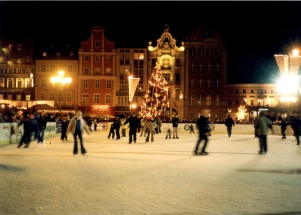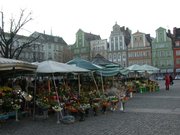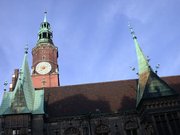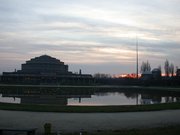Wroclaw
|
|
Wrocław, (Missing image
Ltspkr.png
Image:Ltspkr.png
[:vrɔʦwaf]), German Breslau, Czech Vratislav, Latin Wratislavia; many Polish documents in English use the spelling Wroclaw) is the capital of Silesia in southwestern Poland, situated on the Oder River (Odra). As of 2003, the city had a population of 638,666. It is the principal city of the Lower Silesia region and the administrative seat of the Lower Silesian Voivodship (since 1999), previously of Wrocław Voivodship. The city is also a separate city-county.
| Contents |
City's Name
Wrocław was first recorded in Thietmar's chronicle: John, bishop of Wrocław, a newly established Polish diocese, is mentioned in the year 1000 (Johannem Wrotizlaensem) as was later the city of Wrocław itself (Wortizlawa). The first municipal seal says: Sigillum civitatis Wracislavie, and a simplified city name is mentioned in 1175 as in Wrezlawe.
The early records show that the medieval city name was Wrocisław in Polish and Vratislav in Czech and it means Wrocislaw/Vratislav's town. The Polish name was later simplified in two stages: Wrocisław->Wrotsław->Wrocław and this simplified name has been used since the 12th century. The Czech spelling was used in Latin documents as Wratislavia or Vratislavia, but Polish pronunciation was also infuential as shown in the spelling of Wracislavia. Later the city's name was Germanized to Breslau.
The city is named after a person called Vratislaw/Wrocislaw, though it is unclear what, if any, connection exists to a Czech duke called Vratislav I. It is also possible that the city was named after the tribal duke of the Silesians, or after the early owner of the city, called Vratislav.
The name of the city seems to be an important question for German and Polish nationalists. Among the people of the city, especially those born some years after World War II, the German name Breslau is highly unpopular, and they become quite offended when that name is used. As another example, the warehouse Feniks on the Rynek, built in 1904, showed in November 2004 old pictures of the building. The pictures were described in Polish, but used the original names, such as "Warenhaus Gebrüder Barasch, Breslau".
Names used in other languages include: Vratislav / Vroclav (Slovak, Serbian), Breslavia (Italian), Vroclavas (Lithuanian), Boroszló (Hungarian).
History
Ortsnamen_breslau_1900.jpg
Source: http://www.breslau-wroclaw.de
Situated at a long existing trading place, a city was first recorded in the 10th century as Vratislavia (Wratislaw) (the origin of its various later names) after Vratislav I. The settlement was conquered by the Polish duke Mieszko I in the 990s. Already a place of some importance, it became the capital of Silesia in 1138, where Silesians had founded a settlement south of the river. During the Mongol invasion in 1241 most of the population of the city was evacuated. The settlement was then sacked and burned by the Mongols, but they had no time to besiege the castle where the rest of the burghers found refuge.
Documents of the time refer to the town by many variants of the name, including Bresslau, Presslau, Breslau and Latin Wratislaw. The restored Wrocław town was given Magdeburg Rights in 1262. The first illustration of the city was published in the Schedelsche Weltchronik in 1493.
Under direct overlordship of the Holy Roman Empire the emperors granted government positions to members of various ducal and royal dynasties. The city was a member of the Hanseatic League of northern European trading cities. During much of the Middle Ages Wrocław was ruled by its dukes from the Piast dynasty. In 1335 it, along with almost the entirety of Silesia, was incorporated into the Kingdom of Bohemia and was part of it until the 1740s, and from 1526 was ruled by the Empire's Habsburg dynasty. The overwhelming majority of the inhabitants became Lutheran Protestants during the Reformation, but were forcibly suppressed during the Catholic Reformation by the Jesuits, working with the support of the Habsburg rulers.
After the extinction of local Piast rulers in 1675, the Habsburg Monarchy of Austria inherited Wrocław. They resorted to forceful conversion of the city to back to Catholicism. During the War of the Austrian Succession in the 1740s, Silesia was annexed by the Kingdom of Prussia. Prussia's claims were derived from the agreement, rejected by Habsburgs, between the Piast rulers of the Duchy and the Hohenzollerns who secured the Prussian succession after the extinction of the Piasts.
After the demise of the Holy Roman Empire in 1806, the city remained under Prussian administration and joined Imperial Germany upon its creation in 1871. The kings of Prussia saw to it that Wrocław became a major industrial centre, notably of linen and cotton manufacture, more than tripling in population between 1860 and 1910 to over half a million. Its municipal boundaries were greatly extended in 1928.
UniwersytetWroclawski-Odra.jpg
Many of the city's 10,000 Jews were murdered during the Nazi genocide of World War II. When the Red Army approached in February 1945, Wrocław was declared a fortress and much of the population, which was German, was evacuated, although some 200,000 remained. To build fortifications slave labour was needed to augment civilian workers, and concentration camp prisoners were forced to help.
After a siege of nearly three months, "Festung Breslau" surrendered on May 7 – the last major city in eastern Germany to fall. Some 40,000 Breslauers lay dead in the ruins, and the city was almost 70% destroyed. The city became the scene of horrible war crimes committed by the Red Army against the surviving German population, as in the rest of Silesia and throughout eastern Germany. A modern residential district, around the Kaiserstraße (now: Plac Grunwaldzki), was razed by prisoners (thousands of them died) to construct a military airfield.
Like almost all of Silesia, Wrocław went to Poland under the terms of the agreement reached at the Potsdam Conference. Most of the German inhabitants either escaped before the Red Army, or were resettled in western Germany. It was resettled by Poles either from the small towns and villages from the provinces nearby, or those expelled from territories lost by Poland to the USSR – many of them from Lwów (now L'viv, Ukraine).
Gradually the old city was restored to its beauty. Nearly all the monumental buildings were preserved. Now it is a uniquely European city in present-day Poland, with its architecture echoing that in Austria, Bohemia, or Prussia. Wrocław's Gothic style is originally Silesian, its Baroque style owes much to court builders of Habsburg Austria (Fischer von Erlach, Ch. Tausch), and Wrocław still has a number of buildings by eminent modernist architects, such as Hans Poelzig or Max Berg, the famous Jahrhunderthalle (Hala Ludowa) by Berg (1911-13) being the most important.
In July 1997 the city was hit by a severe flooding of the Oder.
Administrative division
Wrocław is divided into 5 boroughs ( in Polish: dzielnice )
- Fabryczna
- Krzyki
- Psie Pole (litteraly: Dog's Field)
- Stare Miasto (Old Town)
- Śródmieście (City Center)
Significant Events of 20th Century
External links with photo galleries, mostly in Polish.
- 1997 - 1997 great flood of Oder river - photo gallery (http://miasta.gazeta.pl/wroclaw/5,44548,1501462.html)
- 1948 - "Retrieved Country Exhibition" (http://www.wzo1948.prv.pl/)
- 1945 - Festung Breslau (Wrocław Fortress) siege by Soviet Army - photo gallery (http://www.wratislavia.net/festung.htm)
- 1938 - "All-German Festival of Sports & Gymnastics" (Internet Explorer only) (http://www.sportfest1938.prv.pl/)
- 1937 - 12th "All-German Singing Meeting" (http://www.breslau1937.prv.pl)
- 1913 - "100th Aniversary of Leipzig Battle Great Exhibition" (http://www.breslau1913.prv.pl)
- 1907 - 7th "All-German Singing Meeting" (http://www.breslau1907.prv.pl)
- 1903 - 1903 great flood of Oder river (http://www.breslau-wroclaw.de/de/breslau/postcard/projektor/print.php?showId=1000)
Famous people from Wroclaw
- Alois Alzheimer
- Adolf Anderssen
- Max Berg
- Wiktor Bross
- Leszek Czarnecki
- Rafał Dutkiewicz
- count Wojciech Dzieduszycki
- Norbert Elias
- Władysław Frasyniuk
- Lidia Geringer d'Oedenberg
- Eugeniusz Get-Stankiewicz
- Jerzy Grotowski
- Antoni Gucwiński
- Hanna Gucwińska
- Daniel Harrwitz
- Lothar Herbst
- Mirosław Hermaszewski
- Ludwik Hirszfeld
- Marek Hłasko
- Lech Janerka
- Leon Kieres
- Rafał Kubacki
- Gustav Robert Kirchhoff
- Jan Jakub Kolski
- Marek Krajewski
- Ferdinand Lassalle
- Maciej Łagiewski
- Andrzej Jerzy Lech
- Mariusz Łukasiewicz
- Andrzej Markowski
- Ewa Michnik
- Jan Miodek
- Paul Peikert
- Józef Pinior
- Hans Poelzig
- Igor Przegrodzki
- Manfred von Richthofen
- Tadeusz Różewicz
- Wanda Rutkiewicz
- Friedrich Schleiermacher
- Angelus Silesius
- Edith Stein
- Hugo Steinhaus
- Siegbert Tarrasch
- Stanisław Tołpa
- Henryk Tomaszewski
- Andrzej Waligórski
- Piotr Włostowic
- Rafał Wojaczek
- Bogdan Zdrojewski
- Henryk Zieliński
- Andrzej Ziemianski
Nobel Prize laureates from Wrocław
- Theodor Mommsen (1902)
- Philipp Lenard (1905)
- Eduard Buchner (1907)
- Paul Ehrlich (1908)
- Gerhart Hauptmann (1912)
- Fritz Haber (1918)
- Friedrich Bergius (1931)
- Otto Stern (1943)
- Max Born (1954)
- Reinhard Selten (1994)
Historical population
1800: 64,500 inhabitants
1831: 89,500 inhabitants
1850: 114,000 inhabitants
1852: 121,100 inhabitants
1880: 272,900 inhabitants
1900: 422,700 inhabitants
1910: 510,000 inhabitants
1925: 555,200 inhabitants
1933: 625,198 inhabitants
1939: 629,565 inhabitants
1946: 171,000 inhabitants
1960: 431,800 inhabitants
1970: 526,000 inhabitants
1975: 579,900 inhabitants
1980: 617,700 inhabitants
1990: ?
1999: 650,000 inhabitants
2003: 638 000 inhabitants
2004: 633 700 inhabitants
Education
Today's Wrocław has ten state-run universities, including:
- Wrocław University (Uniwersytet Wrocławski (http://www.uni.wroc.pl/)),
- Wrocław University of Technology (Politechnika Wrocławska (http://www.pwr.wroc.pl/)),
- Medical Academy of Wrocław (Wrocławska Akademia Medyczna (http://www.am.wroc.pl/)),
- University School of Physical Education. (Akademia Wychowania Fizycznego (http://www.awf.wroc.pl/)),
- Wrocław University of Economics (Akademia Ekonomiczna im. Oskara Langego (http://www.ae.wroc.pl/))
- The Agricultural University of Wrocław (Akademia Rolnicza we Wrocławiu (http://www.ar.wroc.pl/))
- Academy of Fine Arts in Wrocław (Akademia Sztuk Pięknych we Wrocławiu (http://www.asp.wroc.pl/))
- The Karol Lipiński University of Music (Akademia Muzyczna im. Karola Lipińskiego (http://www.amuz.wroc.pl/))
- University School of Theatre (Państwowa Wyższa Szkoła Teatralna)
- The Tadeusz Kościuszko Land Forces Military Academy (Wyższa Szkoła Oficerska Wojsk Lądowych (http://www.wso.wroc.pl/))
as well as numerous private institutions of higher education, including
- Wyższa Szkoła Filologiczna ([1] (http://www.wsf.edu.pl/)).
Economy and Transportation
Its major industries were traditionally the manufacture of railroad cars and electronics. The city has both an airport and a river port.
Economy
Major Corporations
- Volvo Polska sp. z o.o., Wrocław
- Grupa Lukas, Wrocław
- AB SA, Wrocław
- Polifarb Cieszyn-Wrocław SA, Wrocław
- Kogeneracja SA, Wrocław
- Impel SA, Wrocław
- Europejski Fundusz Leasingowsy SA, Wrocław
- Telefonia Dialog SA, Wrocław
- Wrozamet SA, Wrocław
- American Restaurants sp. z o.o., Wrocław
- Hutmen SA, Wrocław
- MPEC Wroclaw SA, Wrocław
- SAP Polska
Politics
Wrocław constituency
Members of Parliament (Sejm) elected from Wrocław constituency:
- Jan Chaładaj , SLD-UP
- Janusz Dobrosz, PSL
- Hanna Gucwińska, SLD-UP
- Teresa Jasztal, SLD-UP
- Piotr Kozłowski, Samoobrona
- Janusz Krasoń, SLD-UP
- Marek Muszyński, PiS
- Andrzej Otręba, SLD-UP
- Jacek Protasiewicz, PO
- Grzegorz Schetyna, PO
- Antoni Stryjewski, LPR
- Jan Szymański, SLD-UP
- Kazimierz Ujazdowski, PiS
- Bogdan Zdrojewski, PO
Municipal politics
yet to be written
Sports
There are many popular professional sports team in Wrocław area. The most popular sport today is probably basketball thanks to Idea Slask Wrocław the award winning men basketball team (former Polish champion, 2nd place in 2004). Amateur sports are played by thousands of Wroclaw citizens and also in schools of all levels (elementary, secondary, university).
Men's professional teams
Slask_wroclaw_herb.jpg
- Deichman Śląsk Wrocław - (previous names: Idea Śląsk Wrocław, Śląsk Wrocław, CWKS Wrocław) men basketball team, former Polish Champion, 2nd place 2004 in Era Basket Liga
- Śląsk Wrocław - men's football team (Polish Championship in Football 1977; Polish Cup winner 1976, 1987; Polish SuperCup winner 1987)
- Śląsk Wrocław - men's handball team (1st league in season 2003/2004)
- Atlas Wrocław - men dirt_speedway_racing team (1st league in season 2003/2004)
- Gwardia Wrocław - men voleyball team (Polska Liga Siatkowki(PLS) in season 2003/2004)
- Gwardia Wrocław - men boxing team (1st league in season 2003/2004)
- Polar Wrocław - men's football team (3rd league 2004/2005)
- KS Hefra Gwardia Wroclaw - men's volleyball team playing in Polish Volleyball League (Polska Liga Siatkówki, PLS: Seria A in 2003/2004, Seria B in 2004/2005 season).
Women's professional teams
- ZEC ESV Gwardia Wrocław- women's volleyball team playing in Polish Seria A Women's Volleyball League: 6th place in 2003/2004 season.
- AZS Wrocław - women's football team (1st league in season 2003/2004)
- AZS AWF Wrocław - women's handball team (1st league in season 2003/2004)
- AZS AE Wrocław - women table tennis team (1st league in season 2003/2004)
Amateur teams
Photos

A skating rink in the Rynek (Market Square) - Dec 2003.
See also:
External Links
- Wrocław home page (http://www.wroclaw.pl/)
- Wroclaw Life (http://www.wroclaw-life.com)
- Wroclaw University (http://www.uni.wroc.pl/STRONAENG.HTM)
- Wrocław University of Technology (http://www.pwr.wroc.pl/)
- Medical Academy of Wrocław (http://www.am.wroc.pl/)
- University School of Physical Education in Wrocław (http://www.awf.wroc.pl/)
- Photos of Wrocław (http://hydral.com.pl/neo/test.php?dzielnica=01)
- Virtual Wrocław (http://www.wirtualny.wroclaw.pl/)
- Nasze Miasto Wrocław (http://www.naszemiasto.wroclaw.pl/) (Polish)
- Old Postcards from Wroclaw (http://www.vogel-soya.de/bilder/breslau.html)
Books
- Encyklopedia Wrocławia. Wrocław 2001
- Wrocław jego dzieje kultura. Warszawa 1978
- G. Scheuermann. Das Breslau-Lexikon. Dülmen 1994
- K.Maleczyński, M.Morelowski, A.Ptaszycka, Wrocław. Rozwój ubranistyczny. Warszawa 1956
- W.Długoborski, J.Gierowski, K.Maleczyński, Dzieje Wrocławia do roku 1807., Warszawa 1958
- Microcosm, Portrait of a Central European City, by Norman Davies and Roger Moorhouse (Jonathan Cape, 2002) ISBN 0224062433 (ISBN 8324001727 – Polish translation)
| | 
|
|---|---|
| Voivodships of Poland Greater Poland | Kuyavia-Pomerania | Lesser Poland | Łódź | Lower Silesia | Lublin | Lubusz | Masovia | Opole | Podlachia | Pomerania | Świętokrzyskie | Silesia | Subcarpathia | Warmia and Masuria | West Pomerania | |
| Principal cities Warsaw | Łódź | Kraków | Wrocław | Poznań | Gdańsk | Szczecin | Bydgoszcz | Lublin | Katowice | Białystok | Częstochowa | Gdynia | Gorzów Wlkp. | Toruń | Radom | Kielce | Rzeszów | Olsztyn | |
cs:Vratislav (město) da:Breslau de:Breslau eo:Vroclavo fr:Wrocław ko:브로츠와프 id:Wroclaw is:Wrocław la:Vratislavia lv:Vroclava na:Wroclaw nl:Wroclaw nds:Breslau ja:ヴロツワフ no:Wrocław pl:Wrocław pt:Wroclaw ro:Wrocław sl:Vroclav fi:Wrocław sv:Wroclaw





